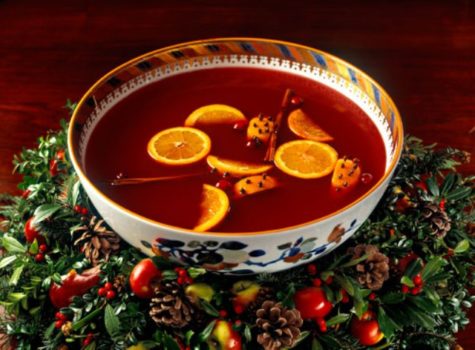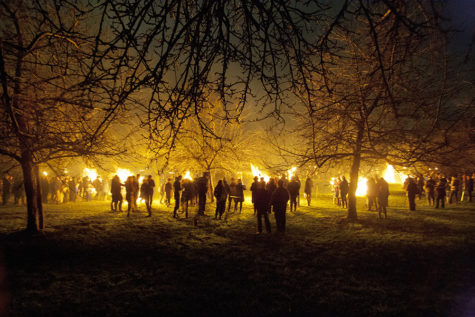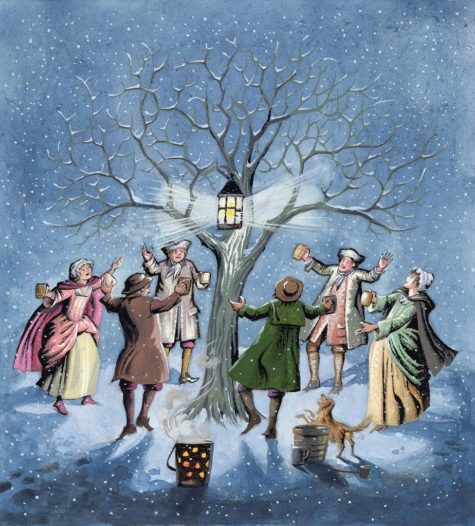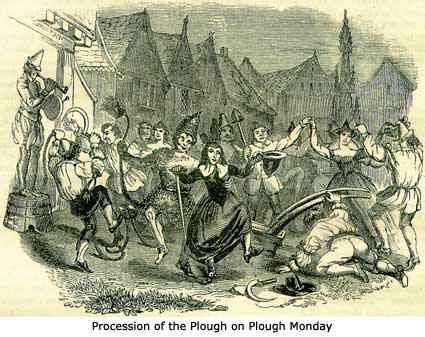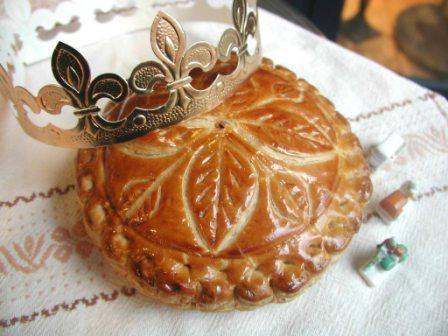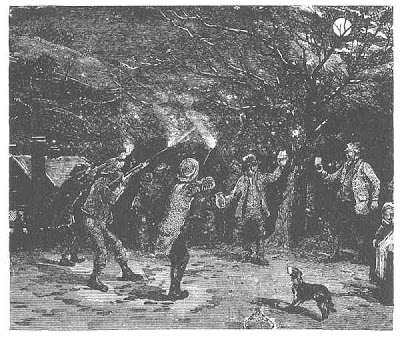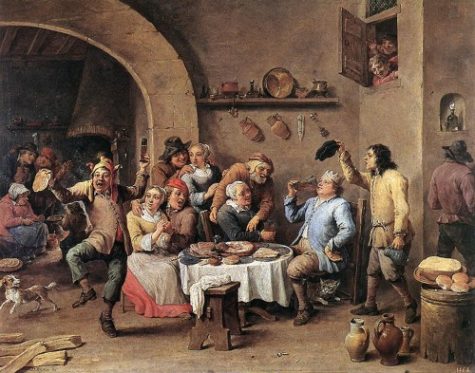Twelfth Night
“Welcome everything! Welcome all alike what has been, and what never was, and what we hope may be, to your shelter underneath the holly, to your places around the Christmas fire, where what is sits.”
~Charles Dickens
The wassail—a centuries old tradition from Great Britain—is a joy-filled party celebrating the Winter Solstice, Christmastime and happy tidings. Indeed, many of the traditions of this likeable event are the originators of well-known seasonal classics (like caroling, for one).
The word wassail itself comes from the old Norse “ves heill,” which literally means “be healthy.” It is a toast of goodwill and is at the heart of what wassailing is all about.
These days a wassail is a party, but, in centuries past wassailing mainly involved people singing carols from door-to-door, such as “Here We Come a Wassailing” or “We Wish You a Merry Christmas.” Sound familiar? The carolers would carry a bowl of wassail, which was a hot mulled wine or some kind of warm, apple-based beverage. Often people floated a piece of toasted bread on top of the steaming wassail, which was the origin of our modern-day expression “I would like to propose a toast.”
When carolers entered a home they would sing, share the wassail and receive eats and drinks themselves (such as plum pudding or shepherd’s pie), at which time toasts for a merry Christmas and happy tidings for a new year would be exchanged by all.
One legend about how Wassailing was created, says that a beautiful Saxon maiden named Rowena presented Prince Vortigen with a bowl of wine while toasting him with the words ‘waes hael‘. Over the centuries, a great deal of ceremony developed around the custom of drinking wassail. The bowl was carried into a room with a great fanfare, a traditional carol about the drink was sung, and finally, the steaming hot beverage was served.
Today, wassails are still held in homes or as public celebrations in many countries throughout the world, such as Great Britain, Canada and the U.S. The celebrations can be as simple as gathering some friends for hot cider to more elaborate celebrations involving the production of short plays (called mummer plays) or caroling through apple orchards.
To host your own wassail:
- Invite friends and family to share the occasion.
- Dress up the house for a festive holiday occasion.
- Serve a warm beverage, such as spiced apple cider, mulled wine or the like, from a bowl. This is a must! Otherwise, it’s not really a wassail.
- Serve food that’s warm and hearty, like beef pot pie or warm potato wedges with bacon, cheese and sour cream toppings. Christmas pudding or any kind of spice cake or pound cake should do nicely for dessert.
- Play festive Christmas music in the background. (Or, better yet, sing along with carols if so inclined.)
- Partake in games that involve teams of players, like charades, Cranium, Pictionary or Taboo.
The object is simply to have a good time and share the joy of the season!
One of the most popular Wassailing Carols:
A Wassail Bowl
Here we come a-wassailing
Among the leaves so green,
Here we come a-wassailing,
So fair to be seen:
Love and joy come to you,
And to you your wassail too,
And God bless you and send you,
A happy New Year,
And God send you,
A happy new year.
Here is a simple wassail ceremony.
- Heat a large container of ale or beer – about 3 or 4 pints.
- Add 1/2 cup sugar and 1/4 cup mixed spices (cinnamon sticks and whole cloves are also excellent)
- Cut up 2 or 3 small sweet apples and add those.
- Add 1 1/4 cup of pineapple juice and the same of orange.
- Squeeze 2 lemons into the brew.
Place over a slow flame; then, before it begins to boil, take off the heat and whip up some cream. Let this float on top of the brew like foam. Put into a suitably large bowl (the more ornate the better).
Toast several slices of bread, if you have fruit cake you can use pieces of that instead.
Now, with a few friends, go out to the tree or trees (see note below).
Dip pieces of toasted bread into the brew and place in the branches of the tree. Hang pieces of bread and cake from the higher twigs to encourage robins (guardian spirits of the trees). Bend the lower branches down and dip their ends in the brew.
Wet the roots liberally with the brew. Pass the rest around and when everyone is thoroughly warmed up, sing a wassailing song. Lift your glasses to the tree and shout “Huzzah!” three times as loudly as you can.
Note:
These don’t have to be apple trees, since any tree will benefit from a well-intentioned blessing, but it is traditional to wassail fruit-bearing trees. You can wassail the trees in your yard, near your home, or trees in some previously selected area.
In Belgium, the Monday after Epiphany is called “lost Monday” and is a day of universal idleness. Hence probably has arisen the custom, not confined, however, to Belgian workmen alone, of idling every Monday or as they call it “making blue Monday.”
Plough-Monday is the first Monday after Twelfth Day (6th of January), so the date varies from year to year. It is so called because, the Christmas holidays being over, the men return to their plough or daily work. It was customary on this day for farm laborers to draw a plough—called “white” on account of the mummers being dressed in white, gaudily trimmed with flowers and ribbons—through the parish, soliciting “plough-money,” which would be spent in a frolic. The queen of the feast was called Bessy. The plough was also called “fond” or “fool,” because the procession is fond or foolish, not serious nor of a business character.
Dressed in clean white smocks decorated with ribbons, the men dragged a plow (plough) through the village and collected money for the “plow light” that was kept burning in the church all year. Often men from several farms joined together to pull the plow through all their villages. They sang and danced their way from village to village to the accompaniment of music. In the evening, each farmer provided a Plough Monday supper for his workers, with plentiful beef and ale for all.
Some accounts depict something far more like Hallowe’en or carnival—men going door to door in outlandish disguise, singing and demanding a gift, and if they were given nothing, ploughing up the front garden. It seems likely that the original rite, like many such door-to-door seasonal processions, had both aspects—the plough was processed because it brought blessings, but ribaldry attended the celebrations and lack of respect for the plough and its attendants brought retribution. I assume the plough was blessed first, before being taken around.
Found in: Encyclopaedia of Superstitions and Almanac.com
Traditionally, a cake was baked for this day, (Jan 17) and a bean hidden somewhere in the mixture and baked along with it. Whoever received the piece of cake with the bean was appointed King or Queen of the Bean for the night, and lead the company in songs and games. Here’s a recipe:
Ingredients:
- 1 cup butter
- 1 cup sugar
- 2 cups flour
- 4 eggs
- 1 1/2 cups currants
- 1 1/2 cups raisins
- 1 1/2 cups sultanas
- 3 tbsp brandy
- 3 tbsp honey
- 1/4 cup candied cherries
- 1 pinch cinnamon
- 1 dried bean
Grease a 12 inch cake tin. Cream the butter and sugar together and stir in the well-beaten eggs and the brandy. Sift the flour with a little cinnamon and fold into the mixture, then stir in the dried fruit.
Add the bean.
Pour the mixture into the tin and bake for three hours at 300′ F. Allow to cool for 30 minutes before turning out. Melt the honey and glaze the top of the cake, and decorate with the cherries.
Recipe source unknown
Wassailing the trees occurred on old “twelfth night”, the 12th night after Christmas eve, or January 17th on the old calendar. (Other calendars show the date as January 5th.)
Obviously traditions varied, but in Devonshire, Herefordshire and in other parts of the West Country of England (as well as elsewhere no doubt) families would hold a feast with cakes, cider and in some areas beer and ale too. After a time of eating and drinking everyone trooped out to the orchard to wassail the trees, and wake them up from winter for the coming season as well as scare off any bad energy, spirits or demons.
Ale, beer or cider soaked toast, in some areas special cakes, would be placed in the tree branches or in a fork of the tree, and then be splashed with more cider. Trees might be beaten with sticks, pounded on, pots and pans clanged, and in appropriate eras, guns that had been loaded with just powder (no shot) would be fired at the trees.
While this went on, others in the group bowed their heads and sang the special “wassail song”.
Variations include:
Old apple tree, we’ll wassail thee
And hoping thou wilt bear
The Lord does know where we shall be
To be merry another year.
To blow well and to bear well
And so merry let us be
Let every man drink up his cup
And health to the old apple tree
(Spoken)
Apples now, hat-fulls, three bushel bag-fulls,
tallets ole-fulls, barn’s floor-fulls,
little heap under the stairs
Hip Hip Hooroo
Hip Hip Hooroo
Hip Hip Hooroo
source: Folk Info
In Old England, The Twelfth Night marked the end of the winter festival that started on Samhain. The Lord of Misrule symbolizes the world turning upside down with the coming of winter. In the middle ages, the Twelfth Night began on the eve of December 25th moving forward 12 days to January 6th, hence the name the twelve days of Christmas.
The Twelfth Night festival marked the onset of the winter solstice, the point in late December when the sun, whose daily arc had reached its lowest, darkest, coldest point, began its rise toward the longer, warmer days and the coming of spring. On December 25th, the ceremonial Yule log was hauled in to start the hearth fire around which its members and visitors would gather throughout the rest of the Christmas festival days.
Twelfth Night was the final frenzy of feasting, drinking and merry making before the townspeople returned to daily life for the remainder of winter. A grand cake was the focus of the celebratory feast as well as Wassail, Fig Pudding and other generous tasty handmade dishes.
In the ancient times of the Roman Saturnalia, the “king of the feast” was elected by beans, and the Twelfth Night cakes included a bean–or, later, a ring or coin. Whoever was given the slice with the prize became the queen and king for the night and much parading and merriment followed.
In the church calendar, Twelfth Night is the evening before Epiphany (January 6). Because the three wise men (or kings) arrived in Bethlehem bearing gifts for the infant Jesus, Epiphany is also called Three Kings Day and a traditional time of gift giving.
Sources: White Magick Alchemy and Almanac.com
